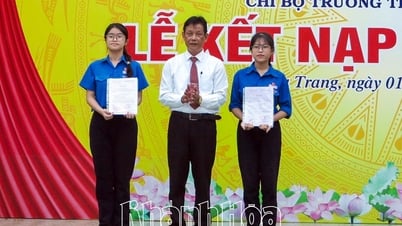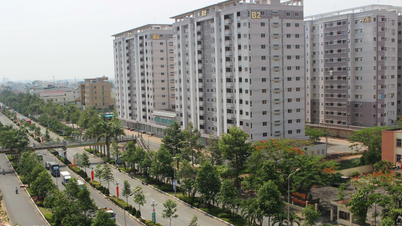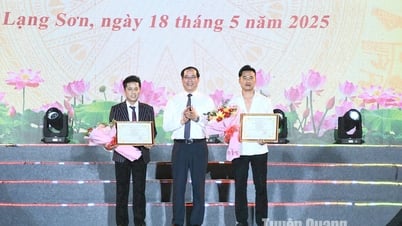This was shared by Deputy Minister of Education and Training Hoang Minh Son at a press conference to inform about the planning of the network of higher education and pedagogical institutions for the period 2021 - 2030, with a vision to 2050.

Mr. Hoang Minh Son, Deputy Minister ofEducation and Training - Photo: NGUYEN BAO
On the afternoon of March 7, the Ministry of Education and Training held a press conference to announce the Planning of the network of higher education and pedagogical institutions, the Planning of the system of specialized educational institutions for people with disabilities and the system of centers to support the development of inclusive education for the period 2021 - 2030, with a vision to 2050.
Universities have not received key investment 'not without opportunities'
At the meeting, Mr. Hoang Minh Son, Deputy Minister of Education and Training, said that this planning of the university education network is not to dissolve, punish or harm schools.
According to him, the most important purpose of this planning is to invest in schools, strengthen and modernize them, and expand their development space.
Schools that do not receive key investment do not "no longer have opportunities, but there are many other programs that are being invested in and developed".
As for the universities that have been invested in this planning, if they do not meet the requirements, it will show ineffective performance.
"Resolution 19 clearly states that ineffective schools must be reorganized, merged or dissolved," Mr. Son said.
According to the university education network planning, by 2030 the scale will be over 3 million learners, reaching 260 students and 23 postgraduate students/10,000 people.
Mr. Son said the target of 260 university students per 10,000 people was set based on the national master plan according to Resolution 81 approved by the National Assembly . With a scale of 3 million university students, the planning took into account the scale of postgraduates and a small number of teacher training colleges.
Faced with concerns that the rapidly growing number of students will affect the demand for jobs after graduation, Mr. Son said the plan was built based on many forecast reports on socio-economic development, forecasting human resource needs, comparing international experiences, etc.
"As the economy develops, the proportion of university graduates must increase. Currently, out of a total of 56 million people of working age, the number of people with secondary education or higher is about 27%, which is still very low. Improving qualifications and skills is to give workers more job opportunities and increase labor productivity," said Mr. Son.
What are the criteria for selecting key investment schools?
Regarding the criteria for selecting key schools for investment, according to Mr. Son, many opinions say that the planning must provide criteria and standards for selection. Any educational institution that "meets the standards" will be selected for investment.
"There is not much time left from now until 2030, so the planning has selected key industries, fields, and universities based on efficiency. We must choose the most prestigious educational institutions in key fields such as science, technology, natural sciences, life sciences, etc.," said Mr. Son.
According to Mr. Son, besides the key investment sectors, schools still have to operate according to market mechanisms, and which sectors have training capacity and society needs can recruit students.
According to the plan, by 2030, Hanoi National University and Ho Chi Minh City National University will be developed into the top universities in Asia. Hue University and Da Nang University will be developed into national universities.
Core universities oriented to develop into regional universities include Vinh University, Nha Trang University, Tay Nguyen University, and Can Tho University.
Physical education universities and teacher training colleges will be merged into other universities or merged with each other. Restructure technical teacher training universities into multidisciplinary universities.
Upgrading and developing Hanoi National University of Education and Ho Chi Minh City University of Education as key national higher education institutions in pedagogy.
This plan also mentions the development of national key universities in a number of fields such as science and technology, health sciences, STEM training...
Source: https://tuoitre.vn/quy-hoach-mang-luoi-dai-hoc-khong-phai-de-lam-ton-thuong-cac-truong-2025030718084869.htm




![[Photo] Ready for the top competitions of Vietnamese table tennis](https://vphoto.vietnam.vn/thumb/1200x675/vietnam/resource/IMAGE/2025/5/18/9c547c497c5a4ade8f98c8e7d44f5a41)

![[Photo] Many young people patiently lined up under the hot sun to receive a special supplement from Nhan Dan Newspaper.](https://vphoto.vietnam.vn/thumb/1200x675/vietnam/resource/IMAGE/2025/5/18/6f19d322f9364f0ebb6fbfe9377842d3)
![[Photo] Party and State leaders attend the special art program "You are Ho Chi Minh"](https://vphoto.vietnam.vn/thumb/1200x675/vietnam/resource/IMAGE/2025/5/18/6895913f94fd4c51aa4564ab14c3f250)











![[Infographic] Achievements of Vietnamese students at the 2025 International Science and Engineering Fair](https://vphoto.vietnam.vn/thumb/402x226/vietnam/resource/IMAGE/2025/5/18/67c3dbcf40744d06bf8164f789fcdc5c)
















































































Comment (0)